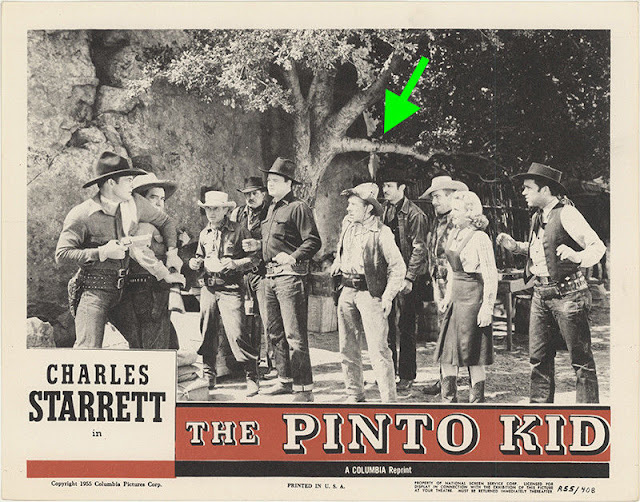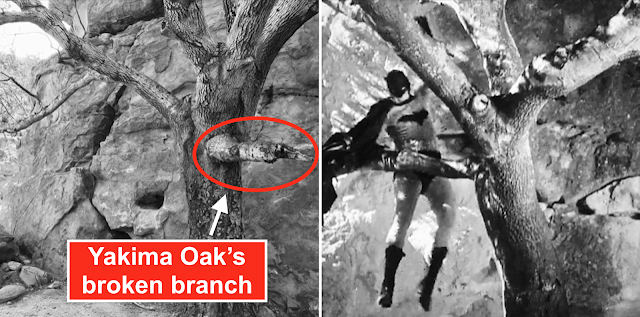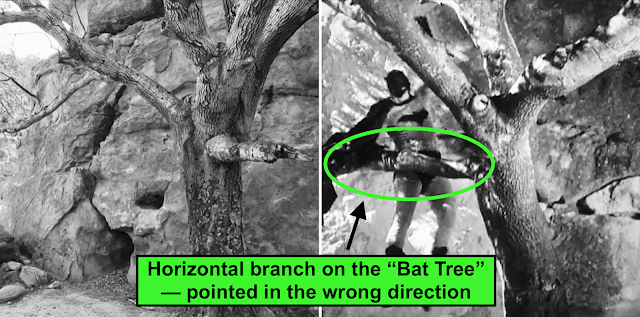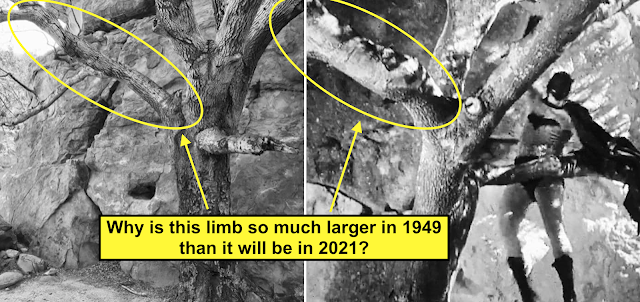A recent series of Facebook posts illustrates how easy it is to get stuff wrong when researching old filming locations — especially when the research involves trees.
This screen shot from the 1949 serial "Batman and Robin" was posted to a Facebook group for fans of old movie serials, with the Facebook user naming the tree the "Bat Tree" and declaring that he had found it in the real world.
That would have been pretty cool, if it were true. Unfortunately, the tree he found is a different tree. The real-world tree happens to be a heavily filmed and relatively well-recognized oak tree located on the Iverson Movie Ranch, known to insiders as the "Yakima Oak."
We've discussed the Yakima Oak previously on this blog — you can click here to learn more about the tree, including its relationship not only to famed stuntman Yakima Canutt, but also to the legendary movie horse Rex.
Rex, who was often billed as "Rex the Wonder Horse" and sometimes as "the King of Wild Horses," starred in a string of silent Westerns in the '20s, but the animal became notorious for having a bad disposition.
Hal Roach cashed in on Rex's rowdy reputation in 1926, casting the horse in the title role of his own Western. "The Devil Horse" also starred Yakima Canutt, and much of the action was filmed on the Iverson Movie Ranch.
Old oak trees can sometimes be used as a way of tracking time in movie location research, because as they get older they get fatter and taller, even while the major limbs and branches pretty much stay in the same place.
The Yakima Oak is a good example, because we have photos not only of the tree in its natural setting, but also of its "career" in the movies — a record that spans about 100 years.
As luck would have it, the Yakima Oak has a unique feature that makes it relatively easy to recognize. Its trademark horizontal branch, pointing toward the west, can be seen even in the tree's earliest photos.
The horizontal branch turns up repeatedly throughout the Yakima Oak's many film and television appearances.
Thanks in part to the horizontal branch, it's easy to identify the Yakima Oak in this lobby card for the Charles Starrett B-Western "The Pinto Kid."
It's also worth noting the rocky background behind the tree, because there's only one rock surface anywhere near the Yakima Oak, and whenever we see that background we know we're looking at the north face of the Sphinx.
Here's another nice shot of the Yakima Oak with its horizontal branch, in a promo still for the Cisco Kid movie "Beauty and the Bandit," starring Gilbert Roland. Here again the rocky background is the base of the Sphinx.
To put the tree's location in perspective, here's a recent shot of the area. You might recognize the northern profile of the Sphinx immediately above the Yakima Oak, along with Tower Rock on the left.
The drought years have been tough on the Yakima Oak, as they have on oak trees throughout the Southwest. Around the former Iverson Ranch a number of historic trees have died, while others are barely hanging on.
Sometime around 2017, the Yakima Oak's famous horizontal branch broke off — but enough of it remains intact that it can still be recognized.
Other old movie trees in the vicinity have not fared nearly as well. Just a few yards north of the Yakima Oak we see the skeletal silhouettes of trees that were thriving 10 years ago but now appear to have lost the fight.
For what it's worth, the Yakima Oak's broken horizontal branch made it into the Facebook post, where the Yakima Oak is "matched" in error with the tree seen in the Batman serial.
As luck would have it, the so-called "Bat Tree" also has a horizontal branch — at least in this stunt shot. However, it points in the opposite direction from the one attached to the Yakima Oak.
We know it's pointed in the wrong direction because once again we see the rocky background, which confirms that we would have to be looking at the north side of the Sphinx — and the branch should be pointing toward the right.
If we try flipping the shot, it still doesn't work. The flipped version of the "Bat Tree," on the right, may actually match the Yakima Oak slightly better than the original version, but we can still find plenty of markers that don't match up.
These two limbs "kind of" look similar when the "Batman" shot is reversed — at least the limbs jut out to the left at similar angles. But the match doesn't hold up to scrutiny, as neither the shape nor the size of the limbs is right.
All of the differences between the two trees have the same simple explanation: They're two different trees.
If we didn't already have sufficient proof, the Facebook user who posted the photos put up three separate posts, each of which adds to the pile of evidence that the trees don't match.
Based on how he juxtaposed these two shots, they're apparently supposed to show the tree from the same angle. Why, then, would the trunk of the tree be curved in 1949 and then later grow straight? Oak trees don't work that way — if anything, they go in the opposite direction, from straight to bent and gnarled.
Even more telling in these two shots, however, is the background rock, which just doesn't match at all. Where are any of the markers in the rock wall — Batman couldn't possibly be blocking the view of all of them.
I can see how one might be seduced by these similar curved indentations in the two rock walls. But on close examination, the two sets of markings don't match.
Besides, even if the two curved markings did happen to match, wouldn't we kinda have to see a huge hole in the rock just below them in both shots?
Another set of mismatched shots from the Facebook posts may provide the best evidence of all. Here we again see the disparity in the trunks of the two trees: one with a pronounced curve to it, the other perfectly straight.
We also plainly see the surviving horizontal branch as it exists in 2021, on the left, with nothing remotely like it seen in the 1949 shot on the right. This alone should be enough to prove that these are two different trees.
But there's more. Once again, the rock walls in the background of the two shots don't match at all. There's not a single marker on either wall that connects the two shots.
Here again there's some temptation to try to match up curved markings on the rocks — including one in the "Batman" shot that looks kind of like a fish. However, if you'll pardon the expression, it's another red herring.
Here's a screen shot from the 1949 serial that provides an unobstructed view of the midsection of the "Bat Tree," so we can do one last comparison between the two trees.
This is a shot of the Yakima Oak that I took on a recent visit to the Iverson Ranch. I can see how someone might get the two trees mixed up, as they do have some similarities.
But even if the two trees seem similar on first impression, they're really quite different. For example, the Yakima Oak has a decided lean to it, with most of the large limbs grouped together on one side of the tree.
The "Bat Tree" is much more balanced, with three fairly equivalent main limbs, each stretching out in its own direction and fairly evenly spaced apart.
But the most convincing of all the clues, as we discussed previously, is that we know the Yakima Oak has always had that horizontal branch reaching westward — going back at least to the 1920s.
There's just no way to explain away the lack of a horizontal branch on that side of the "Bat Tree."
OK, so we know the Yakima Oak is not the Bat Tree. The obvious question, then, is where IS the Bat Tree? The answer to that question is a simple one, but not very satisfying: Nobody knows.
I presume it's somewhere on the former Iverson Movie Ranch — if it survived. Maybe someone who's reading this will join in the fun and go look for it. If you do, and if you happen to find it, I hope you'll let us know. Happy hunting!













































0 Comments